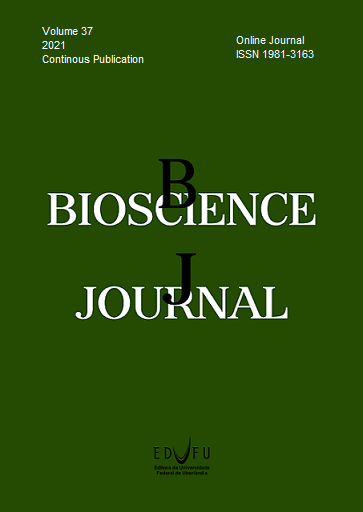Effects of auriculopalpebral nerve block on ocular parameters in dogs
DOI:
https://doi.org/10.14393/BJ-v37n0a2021-54175Keywords:
Bupivacaine, Dog, Locorregional Anesthesia, Ropivacaine.Abstract
The objective of this study was to compare the effects of two local anesthetics used on auriculopalpebral block on eyelid akinesia, tear production, intraocular pressure (IOP) and tear break-up time (TBUT) in conscious dogs. A blind, randomized, prospective study was conducted to determine the effects of auriculopalpebral block using ropivacaine 0.75% and bupivacaine 0.5% in 12 healthy non-brachycephalic dogs (24 eyes). Threat response and eyelid reflex tests, Schirmer tear test (STT), IOP and tear break-up time were conducted before blockage and at 30, 60, 120, 240 and 360 minutes after application. A difference was observed between the values found at 30, 60, 120 and 240 minutes compared to baseline for threat response and eyelid reflex tests in the two groups evaluated, proving eyelid akinesia after blockages. No difference was found for STT, IOP and TBUT between baseline values and post-anesthesia times or between groups. It was possible to conclude that ropivacaine and bupivacaine on auriculopalpebral block in conscious dogs promoted eyelid akinesia for at least 240 minutes, not altering ocular physiological parameters of tear production, intraocular pressure, and tear break-up time after blockages.
References
BAYLEY, K.D. and READ, R.A. Sub-Tenon's anesthesia for canine cataract surgery. Veterinary Ophthalmology. 2018, 21(6), 601-611. https://doi.org/10.1111/vop.12554
BERKUN, Y., et al. Evaluation of adverse reactions to local anesthetics: experience with 236 patients. Annals of Allergy, Asthma & Immunology. 2003, 91(4), 342-345. https://doi.org/10.1016/s1081-1206(10)61680-8
CALDERON, A.L., et al. Immediate allergic cross-reactivity to levobupivacaine and ropivacaine. Anaesthesia. 2012, 68(2), 203-205. https://doi.org/10.1111/j.1365-2044.2012.07314.x
CARARETO, R., et al. Anestesia para cirurgias oftálmicas em canídeos. Revista Portuguesa de Ciências Veterinárias. 2007, 102(561/562), 35-42.
CULLEN, C.L., LIM, C. and SYKES, J. Tear film breakup times in young healthy cats before and after anestesia. Veterinary Ophthalmology. 2005, 8(3), 159-65. https://doi.org/10.1111/j.1463-5224.2005.00347.x
DOUET, J.Y., et al. Effect of sedation with butorphanol on variables pertaining to the ophthalmic examination in dogs. Veterinary Ophthalmology. 2018, 21(5), 452-458. https://doi.org/10.1111 /vop.12530
ESTEVES, A., et al. Anatomical description of the trigeminal nerve [v] and its branching in mongrel dogs. Brazilian Journal of Morphological Sciences. 2009, 26(3-4), 187-192.
EVANGELHO, K., MASTRONARDI, C.A. and DE-LA-TORRE, A. Experimental Models of Glaucoma: A Powerful Translational Tool for the Future Development of New Therapies for Glaucoma in Humans - A Review of the Literature. Medicina. 2019, 55(6), 280. https://doi.org/10.3390/medicina55060280
FEATHERSTONE, H.J. and HEINRICH, C.L., 2013. Ophthalmic Examination and Diagnostics. In: GELATT, K.N., GILGER, B.C. and KERN, T.J. Veterinary Ophthalmology. Iowa: John Wiley & Sons, pp. 533-613.
HAMOR, R.E., et al. Evaluation of results for Schirmer tear tests conducted with and without application of a topical anesthetic in clinically normal dogs of 5 breeds. American Journal of Veterinary Research. 2000, 61(11), 1422-1425. https://doi.org/10.2460/ajvr.2000.61.1422
HARTLEY, C., WILLIAMS, D.L. and ADAMS, V.J. Effect of age, gender, weight, and time of day on tear production in normal dogs. Veterinary Ophthalmology. 2006, 9(1), 53-57. https://doi.org/10.1111/j.1463-5224.2005.00437
HONSHO, C.D.S., et al. Ocular effects of retrobulbar block with different local anesthetics in healthy dogs. Semina: Ciências Agrárias. 2014, 35(5), 2577-2589. https://doi.org/10.5433/1679-0359.2014v35n5p2577
KLAUMANN, P.R. Bloqueio peribulbar com ropivacaína 1% em cães. [Dissertação de Mestrado]. Curitiba: Universidade Federal do Paraná, 2007.
LOCKE, M.C., et al. Assessing the outcomes, risks, and costs of local versus general anesthesia: A review with implications for cutaneous surgery. Journal of the American Academy of Dermatology. 2018, 78(5), 983-988. https://doi.org/10.1016/j.jaad.2018.01.009
MARTINS, B.C. and GALERA, P.D. Semiologia oftálmica em cães e gatos – Revisão de literatura. Medvep. 2011, 9(31), 612-620.
MATHEWS, K., et al. Diretrizes para reconhecimento, avaliação e tratamento da dor. Journal of Small Animal Practice. 2014, 55(6), E10–E68. https://doi.org/10.1111/jsap.12200
MICHOU, J. and LEECE, E. Sedation and analgesia in the standing horse 2. Local anaesthesia and analgesia techniques. In Practice. 2012, 34(10), 578–587. https://doi.org/10.1136/inp.e7507
OFRI, R., 2013. Neuroophthalmology. IN: MAGGS, D.J., MILLER, P.E. and OFRI, R. (eds). Slatter's Fundamentals of Veterinary Ophthalmology. 5th ed. UK: Saunders Elsevier, 318-322. https://doi.org/10.1111/avj.12288
PARK, J.K., CREMERS, S.B. and KOSSLER, A. Neurostimulation for tear production. Current Opinion in Ophthalmology. 2019, 30(5), 386-394. https://doi.org/10.1097/ICU.0000000000000590
SANCHEZ, I. and MARTIN, R. Advances in diagnostic applications for monitoring intraocular pressure in Glaucoma: A review. Journal of Optometry. 2019, 2(4), 211-221. https://doi.org/10.1016/j.optom.2018.12.003
SANTAMARIA, C.M., et al. Drug delivery systems for prolonged duration local anesthesia. Materials Today. 2017, 20(1), 22-31. https://doi.org/10.1016/j.mattod.2016.11.019
SCHROEDER C. and SCHROEDER K., 2019. Local Anesthetics. In: ABD-ELSAYED, A. (ed). Pain. Cham: Spinger, 1013-1017. https://doi.org/10.1007/978-3-319-99124-5
SHILO-BENJAMINI, Y. A review of ophthalmic local and regional anaesthesia in dogs and cats. Veterinary Anaesthesia and Analgesia. 2019, 46(1), 14-27. https://doi.org/10.1016/j.vaa.2018.10.004
SHILO-BENJAMINI, Y., et al. Retrobulbar vs peribulbar regional anesthesia techniques using bupivacaine in dogs. Veterinary Ophthalmology. 2018, 22(2),183-191. https://doi.org/10.1111/vop.12579
VISSER, H.E., et al. Effect of auriculopalpebral nerve block on Schirmer tear test I values in normal horses. Veterinary Ophthalmology. 2017, 20(6), 568-570. https://doi.org/10.1111/vop.12419
WILLIAMS, D. Canine Keratoconjunctivitis Sicca: Current Concepts in Diagnosis and Treatment. Journal of Clinical Ophthalmology and Optometry. 2017, 2(1), 101.
ZIBURA, A.E., et al. A preoperative bupivacaine retrobulbar block offers superior antinociception compared with an intraoperative splash block in dogs undergoing enucleation, Veterinary Ophthalmology. 2019, 23(2), 225-233. https://doi.org/10.1111/vop.12708
Downloads
Published
Issue
Section
License
Copyright (c) 2021 Laura da Costa Luz, Andréia Vitor Couto do Amaral, Jéssica Ribeiro Guimarães, Anne Caroline Assis Silva, Carolina Araújo Neves, Lanay Coímbra Cangussu, Doughlas Regalin

This work is licensed under a Creative Commons Attribution 4.0 International License.





